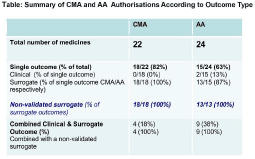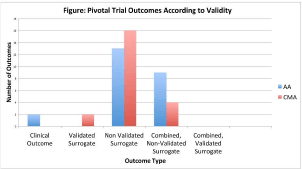| 005P London, UK Current trends in Drug Discovery – Young Scientists and Tomorrow’s Medicines |
The use of surrogate markers in european medicines agency fast track approval pathways-are they validated
Introduction: In situations of unmet medical need, Conditional Marketing Authorisation (CMA) and Accelerated Assessment (AA) pathways are fast-track routes enabling early European Medicines Agency (EMA) marketing approval. CMA is conditional on completing EMA-imposed post-marketing studies. AAs require full safety and efficacy data whilst shortening regulatory assessment time but have no imposed conditions. Surrogate outcomes (or endpoints), intended to predict desired clinical outcomes, reduce drug development time permitting drug discovery benefits to reach patients relatively quickly1. Pivotal studies supporting both CMAs and AAs commonly report surrogate outcomes. Non-validated surrogates may not reflect intended clinical outcomes. Subsequently, drugs may not provide intended benefits. We determined the numbers of CMAs and AAs granted according to clinical and surrogate outcomes, and assessed whether surrogates were validated. Fleming and Powers propose an outcomes hierarchy: Level 1 is a clinical outcome; Level 2, a validated surrogate; Level 3, a non-validated surrogate; Level 4, an un-established correlate 2. Ciani et al. also propose a hierarchy: Level 1 requires controlled trial evidence that surrogate and clinical effects correspond; Level 2 requires ‘consistent association’ between surrogate and clinical outcomes across observational studies; Level 3 requires biological plausibility1
Methods: European Public Assessment Reports (EPARS) were used to assess CMAs and AAs between 2011-2018. PubMed searches identified validated surrogate outcomes. Search terms were: [‘endpoint’] and [validat* surrogate outcome OR validat* surrogate endpoint OR validat* surrogate end-point] and [‘indication’]. Fleming and Ciani hierarchies were used to determine surrogate validity. Fleming ‘Level 2’ and Ciani ‘Level 1’ were judged validated surrogates. Ethics approval was not required.
Results: 22 and 24 medicines were authorised through CMA and AA respectively (Table, Figure). Most authorisations had single outcomes. 0/22 (0%) CMA and 2/24 (8%) AAs used clinical outcomes. For those that were surrogates, the majority were not validated according to the information we could find (Table). 17/46 (37%) EPARs did not discuss nor justify pivotal trial outcomes.
Conclusions: For two fast-track approval pathways, CMA and AA, non-validated surrogate outcomes supported most of the EMA authorisations issued between 2011 and 2018. While surrogate outcomes may expedite the drug discovery processes, there is inherent uncertainty in using non-validated surrogates to support marketing authorisations. In our view, it is time for the regulator to provide guidance on the acceptance of non-validated surrogate outcomes in marketing authorisations and ensure EPARs consistently explain the nature of primary supporting evidence.
References:
(1) Ciani O etal. (2017).Value in Health 20:487-495.
(2) Fleming TR, Powers JH. (2012). Stat Med 31:2973-2984.



